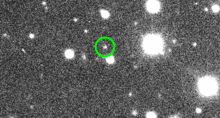Hermippe (moon)
Hermippe /hɜːrˈmɪpiː/, or Jupiter XXX, is a natural satellite of Jupiter. It was discovered by a team of astronomers from the Institute for Astronomy of the University of Hawaii led by David Jewitt and Scott S. Sheppard and Jan Kleyna in 2001, and given the temporary designation S/2001 J 3.[3][4]
 Discovery image of Hermippe (Scott Sheppard and David Jewitt in 2001) | |
| Discovery | |
|---|---|
| Discovered by | David Jewitt, Scott S. Sheppard, Jan Kleyna |
| Discovery date | 2001 |
| Designations | |
Designation | Jupiter XXX |
| Pronunciation | /hɜːrˈmɪpiː/[1] |
Named after | Ἑρμίππη Hermippē |
| S/2001 J 3 | |
| Adjectives | Hermippean /hɜːrmɪˈpiːən/ |
| Orbital characteristics [2] | |
| 21131000 km | |
| Eccentricity | 0.210 |
| −633.9 days | |
| 276.4° | |
| Inclination | 150.7° |
| 347.2° | |
| 298.7° | |
| Satellite of | Jupiter |
| Group | Ananke group |
| Physical characteristics | |
Mean diameter | 4 km |
| 22.1 | |
Hermippe is about 4 kilometres in diameter, and orbits Jupiter at an average distance of 21,500,000 kilometers in about 630 days, at an inclination of 151° to the ecliptic (149° to Jupiter's equator), in a retrograde direction and with an eccentricity of 0.2290.
It was named in August 2003 by the IAU, after Hermippe, a lover of Zeus (Jupiter).[5]
Hermippe belongs to the Ananke group, retrograde irregular moons which orbit Jupiter between 19.3 and 22.7 gigametres (0.152 astronomical units), at inclinations of roughly 150°.
References
- cf. Hermippus in Noah Webster (1884) A Practical Dictionary of the English Language
- S.S. Sheppard (2019), Moons of Jupiter, Carnegie Science, on line
- IAUC 7900: Satellites of Jupiter May 16, 2002 (discovery)
- MPEC 2002-J54: Eleven New Satellites of Jupiter May 15, 2002 (discovery and ephemeris)
- IAUC 8177: Satellites of Jupiter, Saturn, Uranus Archived 2008-07-09 at the Wayback Machine 2003 August (naming the moon)